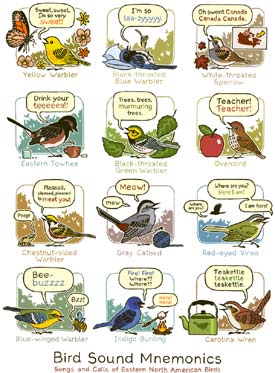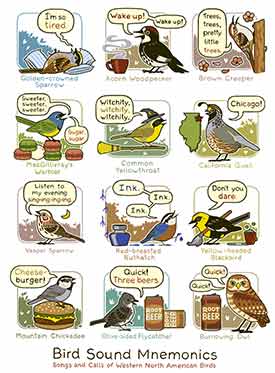4 miles
43rd ave, north/32nd, east/river road trail, south/winchell trail, north
54 degrees
What a wonderful run! Not too fast, not too hard, not too windy. Before I went out for my run, I started thinking more about birds and what I might focus on this month. More how birds sound and less how they look—their coloring, eyes, feathers, etc. Maybe some research on bird biomechanics and migration and navigation and how their feathers and bones and brains work? Too much to tackle in one month. As I wrote this last sentence, I thought about Annie Lamott’s book on writing, Bird by Bird, which I read many years ago and have now requested from the library in audiobook form. I could focus on one bird for each day of the month? I’ll think about it.
Anyway, at the start of my run I was thinking about birdsong and some sites I found with mnemonic devices for recognizing them, like this one: Memorizing bird songs made easy with mnemonics. This site has 2 great comics to help out:
I think I should look up the most common birds in the gorge and then try to learn the mnemonic devices for their sounds. At the beginning of my run, I thought I heard a bird song that started with a tweet tweet, but I don’t think it was a yellow warbler (see comic above). Last summer I wanted to learn more bird calls, but it was too overwhelming and I became distracted with other projects. Thinking about this more, at the end of my run, I remembered an idea I had earlier about not becoming overwhelmed by trying to learn too many things or feeling that there’s always too much that you don’t know. I want to learn just enough to make it interesting–not to become obsessed with knowing every bird song, or depressed by how much others already know. And by interesting, I mean: delightful, creating wonder and astonishment, enabling me to devote attention, provoking my curiosity, connecting me further to a place.
Here are some notes I took about my run shortly after I returned:
- the sewer pipe in the ravine on the Winchell Trail by 44th was dripping/dribbling water, while the pipe by 42nd was—not gushing or rushing or pouring, but more than dripping…what’s the word for that? and why is there more water at 42nd?
- running through the tunnel of trees and hearing at least 3 booms–what were they? transformers blowing or construction-related or a car back-firing?
- so many glints, sparkling like jewels, on the river as I approached the overlook at the start of the Winchell Trail!
- so many sounds of lawn mowers and leaf blowers and bird calls–not a wall of sound, but a veil
- the steep slope up on the Winchell trail near folwell looking insurmountable from a distance
Look!
Near the old stone steps, I heard a deep hollow drumming from a hidden woodpecker, then saw 2 older women standing at the edge of the bluff peering into the trees and trying to find the source of the sound. This reminded me of a passage from Margaret Renkl’s essay “Seeing” in Late Migrations:
One of the nicest things about the lake where I like to walk is that there is nearly always someone on the trail saying, “Look!” Thanks to that natural human urge to share something wonderful, even with a stranger, I have learned this lake’s terrain over the years and know where to look for the well-disguised secrets I would miss on an unfamiliar path. I know that a barred owl frequently perches in a dead tree near a particular bridge. I know that a great blue heron often stand as still as a photograph on a submerged log in one cove. I know the rise whee wild turkeys drag their wing feathers on the ground and blend in with the leaf litter, and I know the bank where beavers climb soundlessly out of the lake. One summer I knew where to look for a hummingbird’s nest because of a stranger with better eyes than mine.
“Seeing” from Late Migrations/ Margaret Renkl
When I read this passage a few days ago, I decided that I want to believe that the strangers on the trail that I encounter could be as generous as this, and I want to take the time to stop and to look or try to look or at least listen to their description of what they see. I want do this instead of assuming the strangers are irritating or clueless or selfish space hoggers. I want to be open to the world instead of closed to it.
Here is a bird poem I found while looking back through my safari reading list. Ted Kooser is wonderful.
A Heron/ Ted Kooser
Maybe twenty yards out from the shoreline
a great blue heron waiting, motionless,
upon a post that seemed to have no purpose
other than to stand there stained with rings
of history as the old lake, breathing sunlight,
rose and fell.
The heron was the color of the water
so that it seemed that I could see the water
through her, as if she were a creature blown
of glass, not smeared by anybody’s fingers,
still clean and delicate and waiting to be filled
with color
although I saw that she was filled already,
from the bulb of her body to the tip of her beak,
not with a color that anyone knew but with
a cloudy fluid that had been distilled
from summer light and now was being aged
and mellowed
though how much longer it might take was
anybody’s guess. But I had been imagining
too long, and she had felt it, too, that threat
of too much beauty being forced upon her,
and spread her glassy wings and lifted off
and flapped away across the water.
What a beautiful poem! I think I want to memorize it so I can have it forever.

